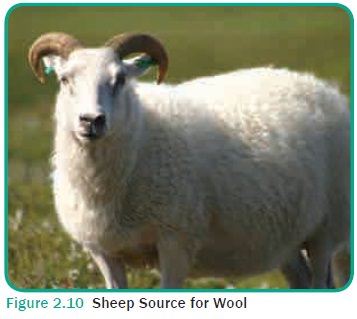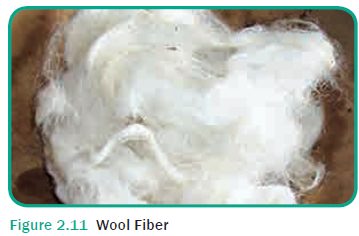Processing, Manufacturing, Characteristic, Uses | Natural Fibres | Textiles - Wool Fibre | 11th Textiles and Dress Designing : Chapter 2 : Natural Fibres
Chapter: 11th Textiles and Dress Designing : Chapter 2 : Natural Fibres
Wool Fibre
WOOL
·
Wool is one of the oldest fibres used for
protection from cold climate.
·
In Tamil wool is called as KAMBULI. The hair of
sheep (Figure 2.10), camel and rabbit are also used as wool fibres. They were
woven as garments and used. Even during early days, woolen clothes were worn by
the people.

·
The quality of wool depends upon the type of
animal, its health, food and climatic conditions and place of breeding.
Principle Origin : Natural
Generic Name : Animal Hair
Chemical Type : Protein
Common Name : Wool
Processing of Wool
The best wool (Figure 2.11) can be obtained from
animals which are free from diseases and chemicals and fed with nutritional
diet. Wool can be taken from sheep’s by two methods- namely wool shearing from
live animals or pulled off from the skin of

The wool obtained by shear-ing is
called fleece or clipped wool. The wool obtained from dead animals is called
pulled wool. Sometimes, chemicals are added in the food of animals which result
in the loss of hair. This is wool is weak when compared to mechanically sheared
wool. The pulled wool and sheared wool can be mixed for yarn formation.
Manufacturing of Wool
Wool Grading and Sorting
Wool fleece is classified based on the quality.
It is graded based on the parts of animal from which it is sheared.
Best quality wool used for clothing-sheared from
shoulder and sides.
Lesser quality wool used for rug making- sheared
from lower legs.
Wool Cleaning and Scouring
The sheared wool has some natural oil present in
them. This collected wool is known as grease wool. It is packed in bales then
washed and sorted again. The recy-cled wool fibre is obtained by separately
reducing the unused and used material to a fibrous mass by picking and
shred-ding process called garneting. Further to remove the oil content, the
fibres are washed in dilute acids, which is known as carbonizing. The resultant
wool is called extract. Further the wool is washed with alkaline solution known
as scouring. The washed wool is dried. Care is taken to leave 12 to 16% of
moisture in the wool. The scoured wool is fluffy therefore it is treated with
vegetable oil which helps in making the softness of wool suitable for spinning.
The wool is further dyed and blended if required.
Characteristic of Wool Fibre
Shape : Fibre contain scales
Length : 3.75
Elongation : Good
Fibre luster : Medium
Elasticity : More
Stretchability : More
Flexibility : More
Density : 1.30 – 1.32 g/cm3
Reaction with acid : Not affected
Reaction with alkalies : Most of alkalies destroy the fibre
Absorbency : Good
Reaction to sunlight : More heat affects the fibre.
Flame : Burns slowly in direct flame, but self extinguishing.
Insects : Damaged by moths and carpet beetles
Drying : Prolonged drying
Dyeing : Absorbs acid and basic dyes readily.
Common Uses of Wool
Clothing (Winter Clothes – Muffler, Sweaters,
Caps)
Household textiles (Blankets, Rugs, Carpets)
Industrial Textiles (insulation material used to
keep the object warm)
Related Topics